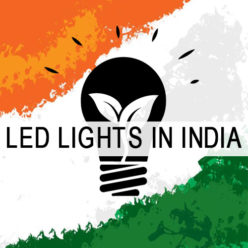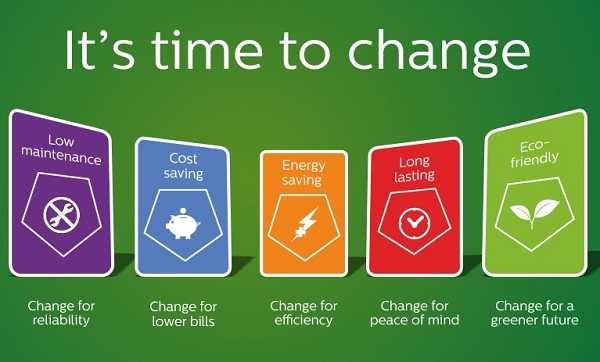The LED lighting market in India has shown a tremendous growth in recent years. The revolutionary LED technology has been around since 1964, but it had some major disadvantages in the beginning. The biggest drawback of LEDs was that they were too expensive for an average consumer to buy. Plus, it produced only a limited area of light when a wide area of light was needed. But now, the price of LED lights has gone down considerably also it is continuously dropping more as the technology advances and the demand increases. Also, developers have successfully eliminated the problem of pin-point lighting by intelligently combining many diodes in different directions. As both of the major problems have been resolved, more and more people are now turning to LED lights.
People have started to realize the energy-efficiency benefits of LEDs. In fact, majority of people nowadays know that choosing LEDs can indeed help them save energy and money at the same time. Eventually, the demand for LED lights has been increasing very quickly. Now, if you are still making some baseless excuses for not replacing your old light bulb with next-gen LED lights, then have a look at the list of the advantages of LED lighting mentioned below. After going through these impressive benefits & advantages of LED lights, you’ll definitely start preferring LEDs over regular incandescent and compact fluorescent bulbs.
Long Lifespan
One of the biggest advantages of LED lighting is that it has a much longer lifespan than conventional light sources. LED’s are known to have an amazing lifespan of more than 50,000 hours, compared to 750 – 2000 hrs for an incandescent bulb, 8000 – 10000 hrs for a fluorescent, and 20000 – 30000 hrs for a linear fluorescent bulb. This astonishing life span of 50000 hours equates to almost 17 years of life if used everyday for 8 hrs a day. This means you don’t have to bother changing your bulbs frequently. Over a period of time, you’ll end up buying less number of bulbs, which in turn would significantly reduce your overall cost of lighting.
Energy Efficient
With a remarkable efficiency of 80 to 90 percent, LED lights are certainly today’s most energy efficient form of lighting available in the market. LED lights operate at 80-90 percent energy efficiency, and this means around 80 percent of the electricity used is converted to light, while the remaining 20 percent is converted to other forms of energy like heat. On the other hand, traditional incandescent lights operate at around 20 percent efficiency only, which means 80 percent of the electricity used is wasted in other forms of energy like heat. In short, LEDs emit more light per watt compared to incandescent bulbs. With continuous sharp rise in electricity costs and guaranteed increase in electricity prices over coming years, using LED lights can definitely help to reduce your lighting bills.
Eco Friendly
Another major advantage of LED lights is that they are absolutely eco-friendly. Most of the standard fluorescent lighting bulbs contain a number of hazardous chemicals & materials like mercury that are unsafe for our environment. However, LED lights are completely free from any form of toxic material and the best part is that they are 100% recyclable. LED lights don’t require any toxic or combustible gases to produce light. Plus, these eco-friendly lights produce at least 80% lower CO2 emissions than standard incandescent and halogen lights. Hence, switching to LED lightings is definitely a large step towards a greener future.
Durability
LED lights are extremely durable. They are manufactured with robust components that can withstand even in the roughest conditions. Like regular incandescent bulbs, LEDs do not contain any brittle filaments or gas filled tubes, and so they are difficult to damage with external shock, vibration or day-to-day wear. In addition, these highly durable and shockproof lights can even operate in extreme temperature environments ranging from -40°C to 185°C.
Low Heat Dissipation
Another excellent feature that proves LED lights are better than other conventional illumination methods is that they have extremely low heat dissipation. What this means is that the LED lights works in such a manner that they produce very little heat while converting the electricity to light. In fact, the amount of heat produced by LED lights is around five times less than the heat produced by halogen bulbs. This makes LED lighting a perfect choice to use around your home, especially in those areas where you spend a lot of time, for example kitchen or office room. The low heat dissipation feature of LED lighting can actually reduce the overall temperature of a building.
Reduced Fire Risk
One of the lesser known benefits of indoor LED lightings is that they significantly reduces the risk of fires by reducing the chance of combusting the surrounding materials. This is because LED lights consume much less electricity and produces less heat, compared to other regular lights. LEDs run at such a low temperature that there is hardly any likelihood of combustion in the nearby materials. Unlike most other lights, an LED does not get hot. That’s why you can even hold a LED bulb in your hand after it has been running for sometime. On the other hand, if you repeat the same task with a halogen globe, then you will end up by burning yourself out.
Ultra Violet and Infra-Red Radiation Free
LED lightings have a unique ability to emit very little infrared (IR) light and almost no ultraviolet (UV) radiation. Both these radiations are extremely harmful for your skin and eyes, especially if you are exposed to them for longer period of time. Hence, switching to LED lights is not only good for your wallet and environment, but also for your health. Moreover, LEDs with no UV radiation and little radiated heat emission is a perfect choice for illumination of UV sensitive objects/materials such as in art galleries, museums, archeological sites etc.
Plug & Play
Just like conventional incandescent, halogen, and fluorescent lights, LED lights are also made available in standard fitting sockets. For instance, led bulbs are available in various screw type and bayonet type fittings similar to regular incandescent bulbs. No special converters or fixtures are required to use LEDs. This clearly means that you can easily replace your older lights with new-gen energy-efficient LED lights without facing any troubles.
Frequent Switching and Instant Lighting
Generally, when we turn on regular CFLs or tubular fluorescent light bulbs, they may take several seconds to reach full brightness.Also, frequent on/off switching severely reduces their operational life expectancy. Using LED lights is the perfect solution to both of these problems. LED lights reach full illumination as soon as you turn them on. Similarly, turning the LED lights on and off frequently will not affect their lifetime or light emission. Moreover, these LED lights always produce a steady light which does not shimmer.
Cost
Many people hesitate to buy LED lights only because they are pretty expensive compared to other conventional lights. However, they must know the fact that electricity and replacement savings over the lifetime of LED lamps are several times greater than the initial investment needed. LED lighting solutions are indeed much more accessible and reasonable than any other traditional lighting.


please send me a price list for wholesale orders
I love LED lights. LED lights are very beneficial for our environment. -LED does not contain mercury. -LED’s can be controlled for brightness and colors. -LED is useful for energy saving in devices. -LED produces less heat.
And i would suggest BRBD Sons.
BRBD Sons are the franchise distributors of most of the major brands of LED’s, wires, cables, switch and accessories including Panasonic, Mitsubishi, Legrand, Finolex, Schneider, Opple LED, KEI, Osram and Anchor panasonic. They are the best lightning designers in Delhi.